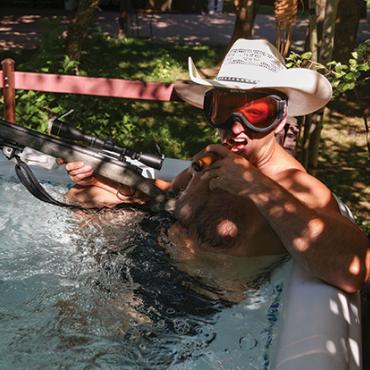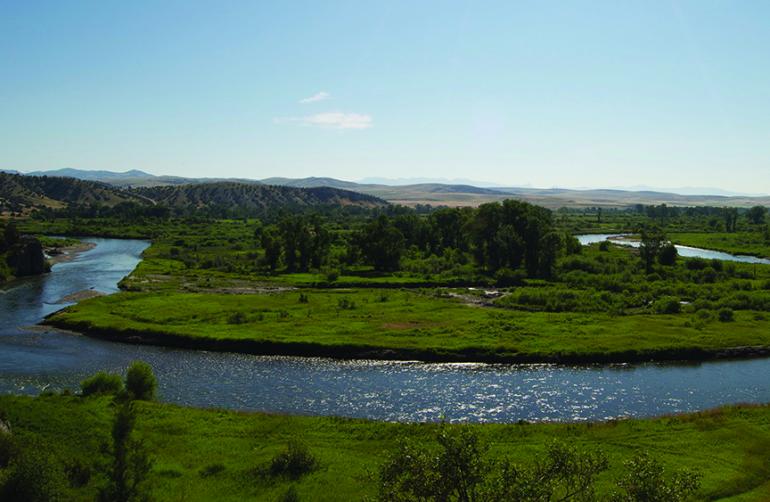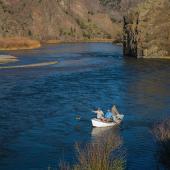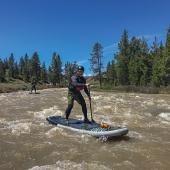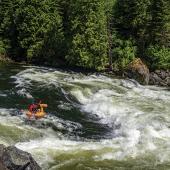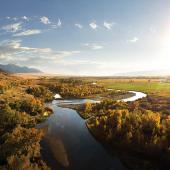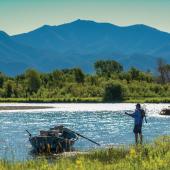Missouri River Safari
A float through history on the Headwaters.
"Rivers are highways that move on," observed Blaise Pascal. "And bear us whither we wish to go." If you wish to float back in time this summer, to a place little changed from the days of Lewis and Clark, where the watery landscape resonates with the histories of American Indians, fur trappers, and explorers — then grab a canoe or driftboat and make for the headwaters. Just outside the town of Three Forks, the "Mighty Mo" comes to life in a braided network of stream channels created by the confluence of the Madison, the Jefferson, and the Gallatin rivers. Not only is the Headwaters an important cultural and historical site, it’s also surprisingly pristine — a wonderland of wildness nestled amid the bustling development of the Gallatin Valley and surrounding area. Just point the car west from downtown Bozeman, and in less than an hour you’ll find yourself floating through a piece of old Montana, down the same route that Lewis and Clark followed two centuries ago, in a place where time seems to have stood firm against the onslaught of human progress.
We set out on a warm August morning, the sun breaking bright over the Bozeman Pass. As we drove west on I-90, our guide, Ken Sinay of Yellowstone Safari Company, assured us of a "wilderness experience" unrivaled in the area. This is a place, he told us, where a greater concentration and diversity of wildlife could be seen than anywhere else on the Missouri, even the Wild & Scenic stretch made famous by Stephen Ambrose’s Undaunted Courage. Ken mentioned otters, beavers, foxes, moose, deer, and an abundance of bird life. My friends and I exchanged giddy smiles, our anticipation mounting as we sped down the interstate toward Three Forks.
Half an hour later, as we slid the boat into the water, I looked up at the cars speeding down I-90 and thought, How can we have a wilderness experience here? Within minutes my skepticism disappeared. A quick stroke of the oars and Ken swept us off the main current into a side channel. Everything became quiet and still. To all sides rose tall river grasses and clumps of willows. Small game trails tunneled through the grass, and we could see fresh tracks at their outlets by the water’s edge. Evidence of beaver activity was everywhere; scent posts, dams, bank burrows, and gnawed limbs appeared around every bend. A sudden flicker of motion caused us all to look up: a Cooper’s hawk had swooped in from a neighboring channel, spotted the boat, and quickly veered off into a clump of cottonwoods. Over the grass and willows we could see the Bridgers rising to the east, the Horseshoe Hills to the north, and barely visible, the Gallatin Range to the south. Around us the land lay flat and still as if asleep. Though predominately private land, there was no sign of man and his industry — no houses, fences, or "No Trespassing" signs. Just the breeze blowing through the willows, and the occasional cry of a killdeer.
We glided along, our state of mind guided alternately by the lazy rhythm of the oarstrokes, Ken’s ongoing narration of the Lewis & Clark expedition, and the thrill of seeing yet another wild Missouri River resident. At one point we rounded a bend and came face-to-face with a whitetail doe. She looked us over and went right back to feeding. Just beyond, we spooked a turtle, followed the bubble trail of a submerged beaver, and watched an enormous fish create a wake as it shot away from the boat. I looked down the serpentine waterway and realized that if we were on our own, we’d probably get lost amid this labyrinth of side channels and backwater sloughs. But Ken maneuvered us through expertly. Occasionally we’d break out into the main current and float awhile, scanning the treetops for ospreys, red-tailed hawks, and bald eagles. Then we’d shoot back into another lost world of willows and backwaters, all connected by watery passages of various widths and depths. It reminded me of the Everglades — how wetlands like these are shaped by water, how these natural passageways guide the activities of all the river’s inhabitants, from the trout to the moose to the eagles overhead. Strange how it all just flows, indefinitely, toward some unknown point, some unknown end. I thought about Montana and how there’s nothing better than floating the river on a warm summer’s day. And I thought about the immortal words of A.A. Milne’s Winnie the Pooh: "Rivers know this: there is no hurry. We shall get there some day."
Yellowstone Safari Company offers full-day river trips that follow the path of Lewis and Clark and the Rocky Mountain Fur Trade. You'll see wildlife, view historic sites, read from the Lewis and Clark journals, and examine artifacts and maps. All the while, your naturalist-guide will share interesting facts about animal behavior and tell exciting tales of Lewis and Clark, American Indians, and mountain men. Yellowstone Safari also offers guided trips into Yellowstone National Park and other areas around Montana. For more information, visit yellowstonesafari.com or call 406-586-1155.

